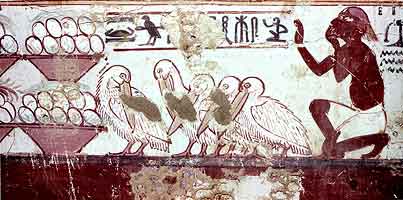|
||||||||||||||||
|
|
||||||||||||||||
|

Humans, Nature and Birds |
From Room 1: Birds as Resources for Human Use |
||||
|
|||||
 Plate 12 |
Pelicans and Their Eggs in Ancient Egypt Art By the time the Sphinx was buried up to its head in sand, Horemheb was a royal scribe and a military general. Though not of royal blood, he became the last king of Egypt’s Eighteenth Dynasty. He was buried in Thebes (c. 1350 BCE) in tomb KV57. This scene was painted on one of its walls. Art historians have pointed out that the chief fowler (the man who appears to be whistling to the pelicans, who are standing beside baskets of their eggs) roughly mimics the figure of the squatting man in the hieroglyphic (just beyond his right hand).[23] Science The Nile lies on a major migratory flyway, and the ancient Egyptians are thought to have had a close relationship with birds--both wild and domesticated. They were aware of seasonal migrations. They could differentiate between resident (nonmigratory) and migratory species, and they recorded various aspects of natural history. The domestication of birds there is a very old practice, one that even predates the dynasties, and ancient images show the use of herons as decoys to attract wetland birds into open traps, and the force-feeding of cranes and waterfowl. But the decision to feature pelicans (Pelecanus sp.) and their eggs in a tomb is puzzling. page 2--> |
||||
| Plate 12 Pelicans from a Wall Painting n the Tomb of Horemheb [untitled wall painting no. 78], (detail), Thebes, Egypt, early 1400s BCE Photo credit: George Hughes. Courtesy of the Oriental Institute of the University of Chicago. © 2008 Darryl Wheye and Donald Kennedy |
|||||